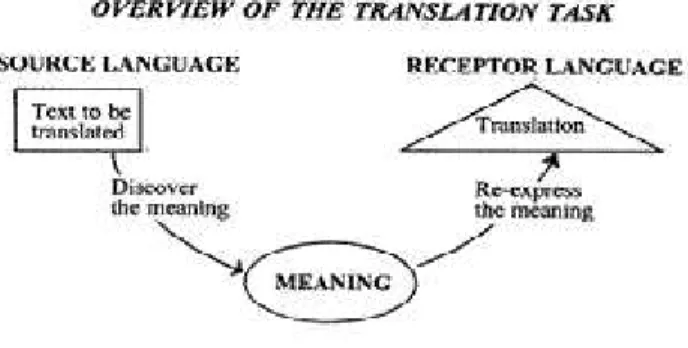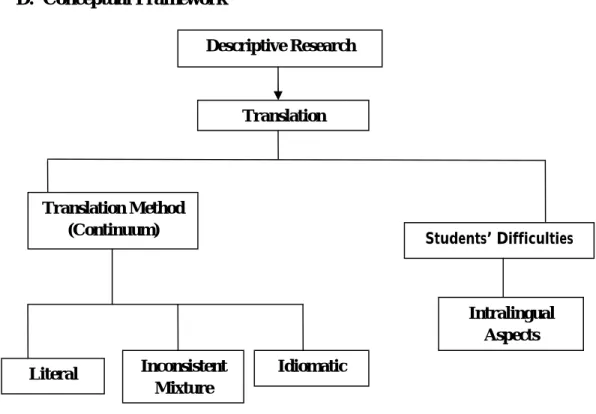Judul Skripsi: A Continuum Analysis of Students' Translation Skills at the Fifth Semester English Department Makassar Muhammadiyah University (A Descriptive Qualitative Research). JudulSkripsi: A Continuum Analysis of Students' Translation Skills at the Fifth Semester English Department Makassar Muhammadiyah University (A Descriptive Qualitative Research). A Continuum Analysis of Students' Translation Skills at the Fifth Semester English Department Makassar Muhammadiyah University (A Descriptive Qualitative Research). Supervised by H.M.Basri Dalle and Farisha Andi Baso).
The objective of this research was to identify students' translation skills and find out translation difficulties in fifth semester students of English Department Makassar Muhammadiyah University. The data were collected from 30 students in 10 classes using the random sampling technique of the 5th semester students of the Department of English Education, to find out the students' translation skills and also to find out the students' difficulties in translation . Great praise and gratitude goes to the almighty God, Allah SWT, who always bestows her compassionate mercy and immense blessing that has helped the writer to complete this thesis titled A Continuous Analysis of Students' Translation Skills in the Semester fifth of the Department of English Makassar Muhammadiyah University.
The author would like to thank everyone who contributed to the completion of this thesis.
Background
Translation is the replacement of text material in one language, source language (SL) into target language (TL). Newmark (1988) said that translation is not only the transfer from one language to another, but also a process of rendering the meaning in the way the author intended the text. Since the translation of text renders the text from SL to TL, it does not simply transfer the lexical unit, but the translator who is responsible for maintaining the originality of the meaning.
According to Larson (1984) as cited in Choliluddin (2005), the purpose of translation is to transfer the meaning of a source language text to a target language text. The meaning itself is retained, although the form can be adjusted by transferring the meaning of the source language text using the natural form of the target language. In conclusion, it can be summarized that translation is an exchange of textual material in one language, SL to TL, where the translation continues to preserve the originality of the meaning.
Another problem that the students face is not easy to translate one sentence from source language to target language and there are some words that have more than one meaning, so the meaning is based on the situation or.
Problem Statement
The researcher chooses a descriptive qualitative research design as a method to study students' abilities, under the title A continuous analysis of students.
Objective of The Research
Significance of The Research
Scope of The Research
Idiomatic translation reproduces the meaning of the source language (that is, the meaning intended by the original communicator) in the natural form of the receiving language. Larson (1984) as cited in Choliluddin (2005) translation consists of translating the meaning of the source language into the receiving language. In the process of translation, the whole meaning of the source text must first be understood.
It will be better if the translator does not change the style of the original. In this translation test, the researcher gave some paragraphs to the researcher's sample. Another instrument is the Translation paper test, with the results of the students' . translation, the researcher found the students' difficulties.
And after he gets the data and evaluates it, he finds that most of the students use literal translation or free translation.
REVIEW OF RELATED LITERATURE
Concept of Translation…
- Definition of Translation
- Process of Translation
- Principle of Translation
Form-based translation tries to follow the form of the source language and is known as literal translation, while meaning-based translation uses the meaning of the source language text in the natural forms of the receptor language and is known as idiomatic translation. According to Larson (1984) as cited by Choliludin, where translating a text, the translator's aim is an idiomatic translation that makes every effort to communicate the meaning of the SL text in the natural forms of the receptor language. Furthermore, he emphasizes that translation is concerned with a study of the lexicon, grammatical structure, communication situation and cultural context of.
The SL form can be changed to the corresponding TL forms to achieve an idiomatic translation. You should not arbitrarily add or subtract anything, although sometimes some of the meaning can be conveyed. The order of words and ideas in the translation should match the original as much as possible.
A good way to avoid the influence of the source language is to slide the text and translate a few sentences out loud from memory.

Definition of difficulties
Newmark (1998) Translation is not simply the transfer of a form in one language to another, but also a process of translating the meaning of a text into another language in the way the author means it. In other words, the translator is responsible for maintaining the originality of the meaning or it will result in bad translation. The other problem is their writing, usually students know how to speak the word but do not know how to write it.
According to Lismayanti, as quoted in Sukirlan (2001), it was found that the students had great difficulty in achieving much better translation output due to inadequate grammatical knowledge, lack of vocabulary, poor understanding of both target and source languages, minimal knowledge of the specific areas. Faradina (2000:7) from the University of Lampung found that students' difficulties in translating are that students have poor understanding of both the target language and the source language. As we know, to make a good translation, students must know the whole meaning both in the source language and in the target language, so that if the students change the whole words, they keep the originality of the text.
Yasminar (2014:95) in IKIP Gunung Sitoli, her research on translation problems for fourth semester students, she found that students tend to make mistakes in about six aspects including diction, writing, meaning, verb, adjective and the use of the words. While Mosleh said in STAIN PAMEKASAN that translation errors were related to the linguistic aspect, the errors that the researcher discovered are words, sentences and meaning, moreover, most of the students in his sample used literal translations or free translations. Then Fatemeh of the Rodaki Institute of Higher Education discovered that the examples from her research on translating the Harry Potter series into Persian did not identify the figures of speech and their associated meaning and did not literally translate the novel.
Based on the above research, the researcher concluded that it is required to know the students' translation skills in Makassar Muhammadiyah University. The research is descriptive qualitative research which will describe the students' skills in translation and the difficulties the students face. In translation, there are many kinds of aspects that we can take as an object of research, but in this research, there are two aspects that the researcher took, the first is the translation method or based on Larson (1984) as a continuum that consists of 7 levels method in translation and then the researcher limits the aspects to three levels, literal, inconsistent blending and idiomatic translation.
There are many kinds of difficulties that students face, but the researcher will focus on intra-linguistic aspects. This research will help the students to expand their knowledge based on the method they used and the teacher will focus on the difficulties of the students so the teacher will give the students mixed topics and materials.

RESEARCH METHOD
Research Variables and Indicators
In this research, the population of fifth semester English department students of Makassar Muhammadiyah University. The researcher gave the students a paper consisting of 1 English paragraph, and the students had 30 minutes to 1 hour to translate it into Indonesian. In addition to the test of the translation work, the researcher used a questionnaire to recheck the students' problems and their opinion about the translation lecture in the fifth semester.
Based on the data obtained, it has been found that the translation lecture is important for the students to help them understand SL text in TL texts easily. Based on the students' confession, it appears that translating from SL to TL is difficult for them. There are three reasons. The students thought that there are many genres of written text, one word in the sentences will have multiple meanings.
It has been found that for translation students tend to make mistakes in 2 aspects, diction and meaning. There is a phrase that will translate sleep deprivation hard for students, the researcher expected. For the second paragraph, students encountered such a difficult point to translate, but most students make their paper understandable.
And then the result of the last section, if the researcher can include the result, in this section, most of them actually have good skills, besides sounds, of course, there is a sentence that the researcher thinks it will be difficult for them, but the students got a good result (Appendix 3). The reason why the researcher takes the students' method is an inconsistent mix because in one paragraph the students translate it literally but it sounds natural and the reader can understand what the students mean. Besides translation subject need more interesting subject so students pay more attention in this subject.
For the researcher, in the research process, give the students precise time so that the students will do the translation text more effectively. If one day researchers will focus on translation, it would be better to learn about the students' perception about material or topic in translation subject.
Population & Sampling
- Population
- Sample